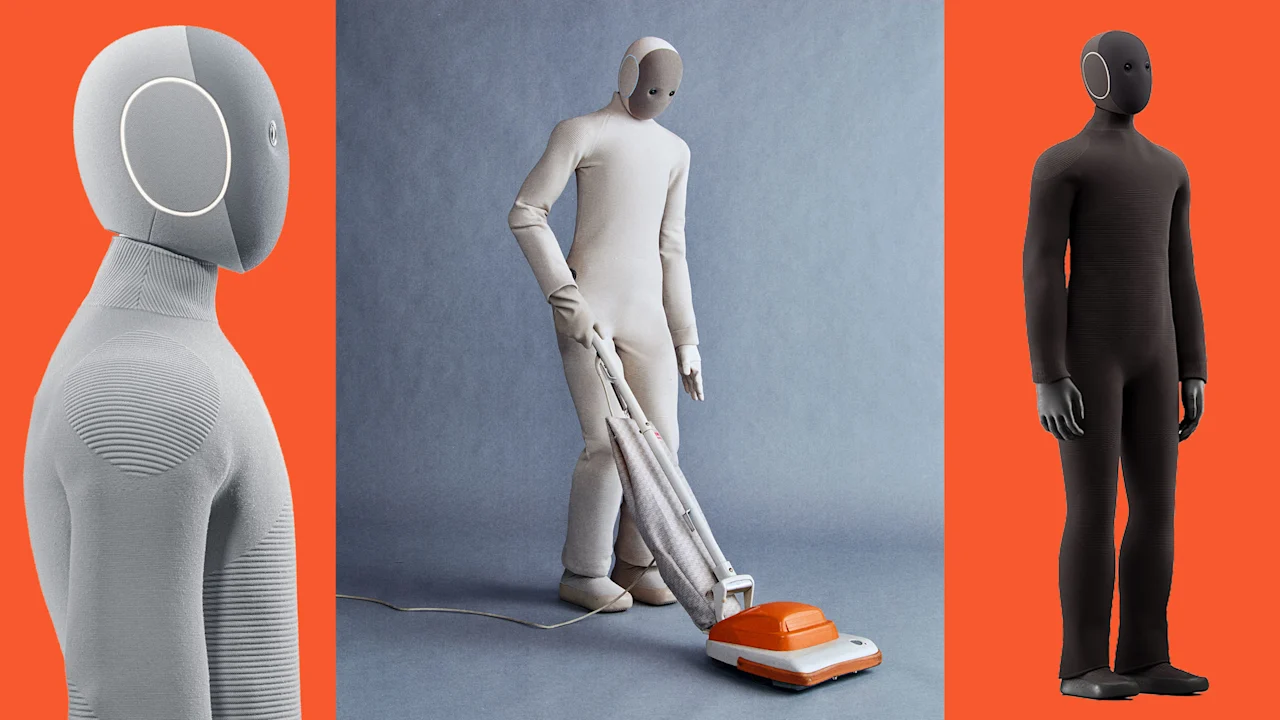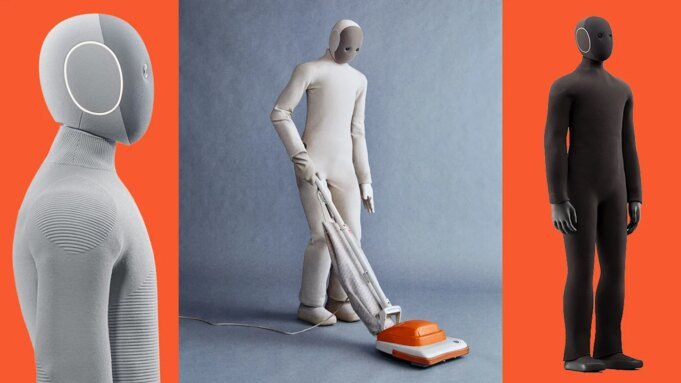Meet the humanoid robot headed for homes

With one sweeping gesture, Dar Sleeper hoists the humanoid robot off the ground. Bracing its back with one arm and its legs with the other, he gently carries it across the room and lowers it onto a sofa, where it lies in repose as if catching a quick nap.It’s a slightly surreal scene, but it has a serious point. I am visiting the Palo Alto headquarters of 1X Technologies, and Sleeper, the company’s VP of growth, is demonstrating that Neo, its home robot, is a lightweight at a mere 66 pounds. That’s a crucial design feature, given that a weighty domestic bot could prove hazardous if it toppled over in the vicinity of a human, a pet, or just a pricey vase.Soon, Neo will take on the ultimate proving ground for a home robot: actual homes. 1X is announcing that it’s taking preorders and plans to ship units to its earliest customers next year. The price is $20,000, or $499 per month as a subscription service, with a six-month minimum. Like a smartphone, the robot will come in multiple color options—tan, gray, and dark brown.Wait, $20,000? There isn’t much precedent for mainstream consumer products in that price range. Cars, of course. (The average price for a new one just topped $50,000.) Maybe boats? Even if you can come up with another example or two, it’s a short list.Then again, 1X founder and CEO Bernd Børnich’s goals for his robots involve attaining a degree of utility that few inventions ever have. He wants to teach Neo to handle every household task that people perform because they need to, not because they want to. Even if the time saved came in bits and pieces—five minutes of dishwasher unloading here, 15 minutes of laundry folding there—it would add up to many hours newly available for more rewarding pursuits.(Photo: Courtesy 1X Technologies)Now multiply that by hundreds of thousands of Neos, which is the quantity Børnich talks about when outlining 1X’s long-term plans for manufacturing capacity. “Potentially it’s the biggest thing ever, with respect to productivity increase across society,” he tells me when I catch up with him via Zoom after my visit to the company.Børnich is hardly the only entrepreneur spinning visions of a world in which humans coexist with teeming masses of robots modeled on them. Companies such as Agility Robotics, Apptronik, and Figure AI are all building humanoid bots of their own. So is Sleeper’s former employer, Tesla, whose Optimus robot has seemingly diverted much of Elon Musk’s attention away from boring old EVs. Most of the nascent category’s focus is on environments such as factories and warehouses, where robots might take on jobs that are dangerous or repetitive—no paychecks required. (1X is presently focused on the home but says it “plans to offer humanoids for the workplace at a later date.”)It’s not just robotics manufacturers that see a vast business in the making. Humanoid bots could fuel enormous growth in chips, foundational models, cloud services, and other elements of the AI economy—a wave of optimism 1X is already riding. In 2023, OpenAI led the company’s $23.5 million Series A2 funding round; its Series B round the following year raised another $100 million. The company also has a strategic alliance with Nvidia, whose CEO, Jensen Huang, accepted a custom leather jacket from Neo during an onstage appearance last March.By 2050, according to a May Morgan Stanley report, there could be more than a billion humanoid robots in service, with the vast majority in commercial and industrial settings. Only 80 million would be in homes, the report speculates. Still, that’s roughly 80 million more humanoid home robots than exist today.(Photo: Courtesy 1X Technologies)For all the grandeur of 1X’s plan to transform how we spend our time, the company is up front that Neo is not yet ready to handle all the drudgery you might want to offload to a home robot. Some of the things it can do are only possible under the control of remote 1X employees, who can orchestrate its actions as if it were a marionette. That human assistance might be a stopgap, but it will also provide 1X with AI training data it can use to make Neo more autonomous over time.My encounter with Neo at 1X’s office did as much to tamp down my impressions of its present form as ratchet them up. The robot gamely ambled about, with a gait that didn’t closely resemble that of a human but was more limber than you might expect. It showed off its strength by hefting a restaurant-sized sack of rice. It also presented me with a chilled bottle of water, though the feat involved a mix of autonomy (walking to the refrigerator) and remote control (opening the fridge and fishing out the bottle), and took much longer than if I’d simply grabbed the water myself.A demo of Neo’s sweeping skills went south when it turned out the cordless vacuum it was wielding had a dead battery. (A human house cleaner would have easily diagnosed and solved the problem.) And some uses 1X is citing for its robot—such as setting birthday reminders and managing grocery lists—do not seem to call for $20,000 of advanced machinery.For Neo to succeed, 1X won’t just need to finish building out the robot’s skill set. It will also have to live up to expectations long steeped in cultural touchstones such as The Jetsons and Star Wars. As Sleeper puts it, “The ultimate North Star, in a lot of people’s minds, is Rosie the robot.” Børnich emphasizes that 1X isn’t entirely sure how Neo will fit into homes, and the company is getting ready to sell them in part to help figure that out.”I don’t think there’s any way we could be as creative as the full set of our customers,” he says. “That’s one of the beauties of actually developing this in public.”Robots come homeOriginally known as Halodi Robotics and founded by Børnich in Norway in 2014, 1X didn’t set out to build a home humanoid right away. Its first robot, Eve, was designed for industrial applications, had grippers instead of hands, and rolled on two wheels. It looked a little like it was riding a built-in Segway.As with anything dependent on generative AI, teaching robots to engage with the world requires vast amounts of training data. As 1X considered where to get that data, it came to see the home as rife with possibilities. That fact nudged it in the direction that eventually led to Neo. “A cup has the ability to give you more data than an entire industrial task,” says Sleeper. “Because that cup could be full. It could be empty. It could be half full. It could be on the kitchen table full, meaning you should leave it there because somebody’s probably drinking it. It can be empty on the coffee table, which means you should take it to the sink or put it in the dishwasher. It could be in the cupboard, meaning that that’s where you go to grab it to give it to somebody when they ask it for it.”Along with data, homes were also full of challenges that Eve had never been designed to overcome, such as climbing stairs to fetch a laundry basket. So when the company formally decided to pursue the home market, it realized it would need to build an all-new robot. ”Every lesson we’ve learned has moved us more and more in the direction of being very confident that the human form factor is the only form factor,” says Sleeper.Humanoids were hardly a new field of robotics research: Børnich says he drew inspiration from examples such as Honda’s Asimo, a staple of trade-show demos early in this century. But he adds that “The type of hardware that we’ve designed here, which is so lightweight and safe and capable, we couldn’t have done that 20 years ago.”Visiting 1X’s Palo Alto operation is certainly an evocative experience. Along with standard tech-company accoutrements such as HP 3-D printers cranking out prototype parts, it’s full of robots—from the Neo I watched in action to a row of decommissioned Eves sitting next to a staircase. One skinless Neo hangs from a hook in an area thrumming with human technicians: “It’s very Westworld in here,” says Sleeper.Much of Neo’s innovation lies underneath its knit turtleneck jumpsuit. 1X created its own motors, which it says have five times more torque than any other in the world and help the robot lift up to 154 pounds and carry up to 50 pounds. It equipped the robot with a tendon-drive transmission system, intended to reduce weight while increasing safety and affordability. It engineered hands with 22 degrees of freedom—only five less than human ones—and attached them to longer-than-human arms, since robots have no shoulder blades. The company even custom-designed its own batteries. Neo officially runs for four hours on a charge, though it can top off its own battery as necessary—“You’ll never really have to think about it,” promises Sleeper.(Photo: Courtesy 1X Technologies)At 5 feet 6 inches, Neo is 2.5 inches taller than the average American woman and 3 inches shorter than the average man. Its physique is intentionally neither feminine nor masculine: “It was important that nobody be sexually attracted to it,” says Sleeper, suggesting scenarios I prefer not to contemplate any further. Owners will, however, be able to choose between female and male speaking voices. (For the record, Sleeper referred to Neo as “he” during our conversation, but said that opinions on its gender, if any, vary.)Regardless of how capable Neo’s hardware may be, 1X’s AI platform will determine what it can actually do around a house. Its elements include machine vision, audio recognition, and an onboard LLM with memory that provides ongoing context. Melding all of them will allow the robot to listen for instructions, navigate its surroundings and the objects therein, and perform useful tasks. The LLM will also power Neo’s personality. That will come out as people talk to it, which 1X thinks they may do quite a lot. Rather than mimicking human companionship, the company is aiming to make the robot a lovable, pet-like sidekick—Hobbes to the owner’s Calvin, Sleeper says.All of this is where the experience that 1X plans to ship next year will be, at best, a first rough draft. The company’s examples of jobs Neo will be able to perform autonomously on day one are modest: fetching items, greeting guests at the door, switching off the lights at night. It will handle these and other responsibilities by breaking them down into 10-second “microtasks.” At the moment, things get tricky if much more than three microtasks are involved.1X expects its first customers to understand that they’re buying into a long-term proposition. “As you continue to use your robot, you’ll get more updates, and your basic autonomy features will expand to be able to do more,” says Sleeper. “Your robot can always try something if you ask it to, like getting you a beer. And if it hasn’t learned how to do that yet efficiently, it will fail. Some people might hate it. But those aren’t the early users.”(Historical footnote: Delivering beer may be home robotics’ most enduring example of an exciting application. It’s what a bot called Androbot did for Atari cofounder Nolan Bushnell during an onstage demo at CES in 1983, to cheers from the audience.)From the beginning, Neo will be able to go beyond basic autonomy through its remote-assistance feature. Called Chores, it will enable California-based 1X employees to see through Neo’s eyes and steer the robot through more elaborate processes. The company has anticipated privacy concerns over its bot becoming a roaming window into its customers’ homes: Chores sessions are only initiated if users explicitly ask for them, and can be terminated at any time. When they’re active, the LED ring around Neo’s ears will change from white to blue.Remote-controlled robots made me think of the Tesla event held a year ago whose Optimus bartenders provoked amazement, at least at first. When it turned out they’d been puppeteered by off-site humans, the awe dissipated. Sleeper told me that 1X doesn’t consider Chores to violate the fundamental idea of a home robot: “We just think that there’s actually quite a lot of value to come from these expert operators being able to supplement and support your experience.” As they do, the training data they generate may redound to the benefit of future Neo owners.To err is humanoidBørnich, who has been living with Neo at home for “quite some time,” professes not to be overly concerned with any flaws in the current experience, cheerfully calling them “robotic slop.” Maybe Neo “didn’t put all of the glasses in the cabinet exactly in line, like this master Japanese butler, but it put them in there,” he says by way of example. “Okay, the shirt isn’t folded perfectly, but it’s folded pretty well, and I didn’t need to do it. I’m actually very happy.”But he also expects that Neo will quickly prove its worth to a fairly broad audience. How soon? By 2027, the purchase will be “a no-brainer,” he predicts.Comparing home robots to smartphones—which have tended to get more powerful over time rather than much cheaper—Børnich says that $20,000 may remain Neo’s price tag even after 1X can scale up production well beyond its current capacity of 25,000 U.S.-made robots a year. “You just want to keep expanding the capabilities until you can not only do what humans can do, but you can also do a lot of things that we can’t,” he explains.A lot has to go right for these ambitions to play out, including 1X having access to the necessary capital. Last month, The Information’s Wayne Ma, Natasha Mascarenhas, and Valida Pau reported that the company was seeking $1 billion in additional funding at a $10 billion valuation, dwarfing its previous numbers.For now, 1X is still working on teaching Neo to tackle work that humans can literally do with their eyes closed. But when I ask Børnich if he considers the company’s ultimate business model to lie in selling home robots or building services around them, he pushes back on the assumption that it’s a home robotics company at all. “Actually, I think of 1X mainly as an AGI company,” he says. “We want to solve intelligence and solve artificial labor across society. Digitally and physically—the entire substrate. And you’re not going get there without robots.” Now 1X has to prove that it will get there with them.The early-rate deadline for Fast Company’s World Changing Ideas Awards is Friday, November 14, at 11:59 p.m. PT. Apply today.
已发布: 2025-10-28 18:00:00











